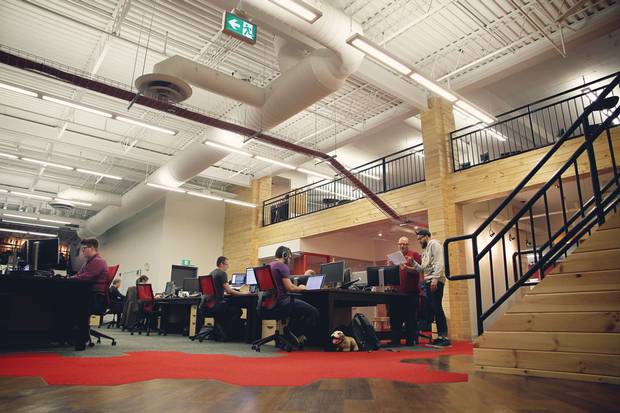The series: We look at decision makers among Canada's mid-sized companies who took successful action in a competitive global digital economy.
For some, Times Square is the place where the oversized ball drops to ring in the new year at the stroke of midnight each December 31.
For Mike Johnston, though, the New York City tourist trap has a slightly different connotation.
Amid the neon glow of digital advertisements, it was where the co-founder, president and chief executive officer of Nova Scotia-based digital design firm, REDspace first truly understood that he was taking his company in a whole new direction.
He had started the company with a retired IBM country general manager in 2001, with a heavy focus on building corporate e-learning systems for IBM. But after attracting some interest from the head of technology at one of the Viacom Inc. brands – who had a soft spot for the Maritimes after going to school in Halifax – he was invited down to Manhattan to pitch for a project building a video player for Nickelodeon.

Mike Johnston, the co-founder, president and chief executive officer of Nova Scotia-based digital design firm, REDspace: media work ‘dramatically eclipsed’ the company’s original focus on building corporate e-learning systems for IBM.
Chris Toms/REDspace
"I show up in Times Square in a new blue pinstripe suit and in walks the head of technology for Viacom in rumpled jeans and a plaid shirt and I felt completely out of place," Mr. Johnston said. "I had no idea what the media sector in New York was like."
But after winning that pitch and doing a few more projects for Nickelodeon, Mr. Johnston suggested his company provide a dedicated team for the American TV network. However, when it then requested 10 people full-time to work on its properties, the Canadian company was forced to expand in a hurry.
"At that time we were probably 25, 30 people [overall], so we had to grow pretty aggressively to hit that," he said. "We did it, and that relationship that started 11 years ago has grown into probably 35-ish full-time folks that service a lot of the Viacom brands."

The switch meant the company ended up growing from about 25 people to about 175.
REDspace
Thanks to that transition, the entire company has grown to about 175 people, based in Halifax. And while the company, which originally started as Team Space, still services IBM's needs in the corporate learning space, its abilities to program web and mobile platforms, gaming systems and video streaming platforms have become its principal selling point.
"Three-quarters of the business at least is media," Mr. Johnston says. "So one dramatically eclipsed the other, to the point where we just ended up changing the name of the company."
Mr. Johnston says his company is really most useful to big enterprises, based largely in New York City and Los Angeles. The company's client base, which has grown about 35 per cent in the past year, now includes the likes of Turner, Fox and CBS.
Thanks to the association with a long-time, landmark client such as IBM, along with winning a pair of Emmy awards for two of its iPad apps, REDspace's digital innovation has attracted other suitors in sectors such as aerospace and defence.
"They want to work with a company that … knows how to run a big project, has security and has the IBM pedigree," Mr. Johnston says. "So we're finding that that one-two punch is still very attractive. We're very glad we shifted out of just being an e-learning vendor."
With new digital platforms springing up all the time, it is a constant battle for REDspace to stay on top of the latest technology and innovations, so the CEO adds that the company is in a continual mode of research and development.
However, while he adds that there is a global shortage of talent in the digital space, the universities that teach those skills that are located in Nova Scotia, combined with the prestige of working with a company associated with big brands such as Fox and CBS, has helped REDspace attract talent.
When it comes to competing with other digital design companies south of the border, Mr. Johnston adds that his company actually has somewhat of an advantage in being Canadian.
"We've tried really hard to maintain a culture that's collaborative, that's friendly, that's problem solving, that's quintessentially Canadian, and I think that kind of sets us apart from the American competition that we're up against," he said.

Thanks to its association with a long-time, landmark client such as IBM, REDspace has attracted other companies in sectors such as aerospace and defence.
REDspace
While changing direction for any company brings its own set of problems, by staying in the digital sphere it was already operating in, REDspace's chances of success went up dramatically, says one industry expert.
"If you pivot into a direction that requires you to have completely different assets and capabilities than typically you can rely on, the odds of you succeeding dramatically drop," says Herbert Blum, head of the Americas telecom practice for the management consultancy Bain & Company in Toronto.
In addition, having large corporate clients gives REDspace an advantage because it can do the kind of digital work that can get bogged down in bureaucracy in a larger company.
"They can't hire talent that would work for 72 hours straight to do a code binge," Mr. Blum says of corporations such as Fox or Viacom, in contrast to a smaller, more nimble company, such as REDspace.
For any company looking to transition into a new direction, one idea worth considering is to create an environment within the original company to isolate the risk, rather than spinning it out to let the new group fend for itself.
"In terms of the spinoff, then, the financial risk lies totally with the business unit and if it fails, then everybody loses their job," says Rudy Fischer, a partner at RK Fischer and Associates in Toronto. "Whereas the [strategy], if you keep it internal, at least you get to retain some of your key talent and then you can redeploy if it doesn't work out."

For any company looking to transition into a new direction, one idea worth considering is to create an environment within the original company to isolate the risk, rather than spinning it out to let the new group fend for itself, says Rudy Fischer, a partner at RK Fischer and Associates in Toronto.
Rudy Fischer
For companies working in the digital space, Mr. Fischer says they have to almost be in a constant state of evolution. Failing that, there is a risk of being left behind.
So rather than planning in yearly chunks, he says that in the digital sector, companies have to consider everything in three-month time periods. That way, companies can make sure they have the right technology, as well as having staff with the right skills.
"We would … create a skills-gap matrix in terms of, okay, here's what we need to grow," Mr. Fischer said. "Either you hire it, or you develop it or you rent it. So depending on how you want to play your cards, you can use a combination of the three."
MORE FROM THE SERIES:


